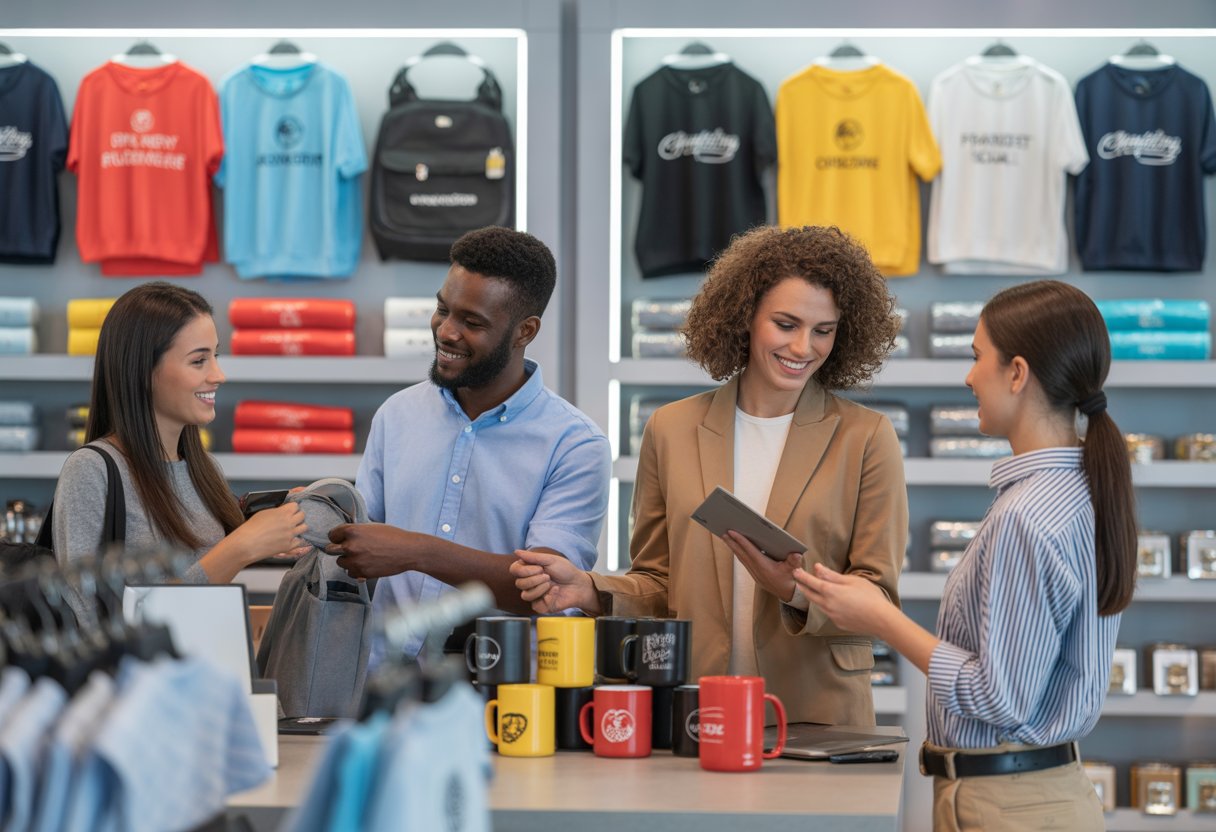Branded merchandise is more than just a way to promote a company’s logo. It helps businesses build stronger connections with their customers by making the brand feel familiar and valued in everyday life. When customers receive useful or well-designed merchandise, they are more likely to remember the brand and form a positive impression.

Branded merchandise can increase customer loyalty by encouraging repeat business and long-term engagement. Customers often see branded items as rewards or tokens of appreciation, which can lead to greater satisfaction and a stronger bond with the company. Choosing merchandise that reflects the brand’s values and style reinforces trust and encourages customers to stay loyal.
Businesses that use branded merchandise thoughtfully can stand out in a crowded market. Strategic distribution, whether through contests, promotions, or loyalty programmes, ensures that customers feel recognised and connected to the brand.
Understanding Branded Merchandise and Customer Loyalty

Branded merchandise and promotional products are key tools that help businesses earn trust and keep customers returning. Well-designed products strengthen brand recognition, increase satisfaction, and shape the way customers feel about a company.
Defining Branded Merchandise and Promotional Products
Branded merchandise is any item that displays a company’s logo, name, or colours. Common examples include t-shirts, pens, mugs, and tote bags. Promotional products are a type of branded merchandise specifically given away to attract attention or reward customers.
These items aim to keep the business in the customer’s mind. Giving quality merchandise creates a stronger connection between the brand and the person who receives the product. People often use these items daily, so they provide repeated exposure to the brand name.
Table 1: Common Examples of Branded Merchandise
| Item | Purpose | Typical Usage |
|---|---|---|
| T-Shirts | Brand awareness | Worn casually |
| Mugs | Office loyalty | Desk, home use |
| Pens | Mass giveaways | Everyday writing |
| Tote Bags | Eco-friendly branding | Shopping, errands |
The Relationship Between Branded Merchandise and Customer Loyalty
Branded merchandise can build customer loyalty by providing something useful, memorable, and desirable. When a company offers high-quality, thoughtfully designed items, customers may feel valued and more likely to remember the brand.
A sturdy, stylish product makes a positive impression and sets a brand apart from competitors who might offer cheap or forgettable items. Loyalty increases as customers see the brand as reliable and trustworthy, leading to repeat business and referrals.
Customers who regularly use branded items become walking ambassadors. The visibility of the merchandise helps spread awareness while strengthening the perception of quality and reliability within the brand community.
Key Components of Customer Engagement
Customer engagement is more than just purchasing a product; it involves ongoing interactions and emotional connections. Branded merchandise can support this by creating touchpoints that remind people of positive experiences with the brand.
Personalisation is one important component. When merchandise is tailored or feels relevant, customers feel recognised and appreciated. Social proof, such as seeing others use branded products, also encourages engagement through a sense of community.
List: Key Engagement Strategies
- Offer merchandise that aligns with customers’ interests
- Use feedback to improve product selection
- Host events or campaigns involving branded giveaways
- Encourage sharing on social media with branded items
Good engagement through branded merchandise builds lasting relationships and keeps a brand at the front of customers’ minds.
The Role of Branded Merchandise in Building Brand Recognition

Branded merchandise plays a direct role in strengthening how consumers see and remember a business. Key benefits include boosting brand awareness, leaving a positive and lasting impression, and making the brand easier to recognise and recall.
Brand Awareness and Visibility
Branded merchandise increases brand awareness by putting a company’s name, logo, or message in front of many people. Items like t-shirts, mugs, or pens serve as moving advertisements, reaching both the person who received the item and those around them. This frequent exposure helps embed the brand into people’s daily routines.
Visibility grows each time someone uses or wears branded merchandise in public places such as schools, offices, or events. Merchandising strategies that focus on everyday items often achieve a wide reach with a low ongoing cost. This steady exposure means the brand stays at the front of consumers’ minds. Bold logos, consistent colours, and catchy slogans printed on products help reinforce the brand’s image.
Creating a Lasting Impression
Receiving branded merchandise often leaves a stronger impression compared to seeing a digital ad or a billboard. When customers get a useful or high-quality item, it creates positive feelings towards the brand and builds trust. This physical interaction helps make the brand feel more tangible and memorable.
A well-chosen item can improve how people view the business’s brand image. For example, eco-friendly or premium merchandise can signal that a company cares about the environment or prioritises quality. The act of giving—such as a company handing out free branded water bottles during a hot day—can create goodwill that lasts long after the item is received.
Brand Recall and Recognition
Regular use of branded merchandise makes it easier for people to remember and recognise a company’s logo or message. When customers see or use the same branded item over time, it strengthens their recall—making it more likely they will think of the business when making a purchase decision.
Brand recall is improved by the durability and usefulness of the item. For instance, a branded notebook used daily ensures the brand is seen repeatedly. Visual consistency—using the same logo, colours, and fonts on merchandise as in other marketing materials—also helps consumers identify the brand instantly in shops or online. This kind of recognition supports stronger marketing campaigns and more loyal customers.
Strategies for Enhancing Customer Loyalty Through Merchandise
Branded merchandise can boost loyalty when it is used to make customers feel appreciated and valued. Items that connect with customers on a personal level, fit smoothly into loyalty programmes, and reward repeat visits can increase satisfaction and foster a sense of belonging.
Effective Use in Loyalty Programmes
Integrating branded merchandise into loyalty programmes can make rewards more tangible and memorable. Customers often respond well when they receive physical gifts, such as custom tote bags, mugs, or T-shirts, after meeting specific spending milestones. These items act as reminders of positive brand experiences.
Many companies create tiered reward systems. For example:
| Tier | Reward Example |
|---|---|
| Silver | Branded keychain |
| Gold | Custom water bottle |
| Platinum | Limited edition hoodie |
This approach encourages customers to engage more and reach higher tiers for exclusive merchandise. Selecting quality, useful items matters, as it signals that the company values its customers’ loyalty and wants to provide real benefits.
Personalisation and Emotional Connections
Personalised merchandise strengthens emotional connections. When a customer receives an item with their name or a design relevant to their preferences, it creates a more personal link with the brand. This can lead to increased feelings of satisfaction and attachment.
Examples of personalisation include:
- Printing the customer’s name on reusable bags
- Offering items with custom messages
- Creating limited runs based on local events or community interests
Developing a sense of belonging is easier when merchandise reflects the customer’s identity or interests. These connections help transform casual buyers into loyal brand supporters.
Customer Retention and Repeat Purchases
Merchandise can encourage customers to keep coming back. Special items given for repeat purchases or as thank-yous for long-term support remind customers why they chose the brand in the first place.
For example, after a set number of purchases, customers might receive branded merchandise not available elsewhere. This exclusivity can motivate them to shop more frequently.
Customer retention improves when people feel valued and recognised. Offering thoughtful, exclusive items as part of a rewards scheme can reinforce positive feelings and build habits that turn one-time buyers into regulars.
Selecting and Using High-Quality Branded Products
Providing well-chosen, high-quality branded merchandise can shape how people see a company and build customer loyalty. Thoughtful product selection, attention to quality, and offering exclusive items help strengthen relationships and can keep a brand front of mind.
Choosing the Right Promotional Items
The products chosen should reflect the brand and cater to the interests of the target audience. Items like branded t-shirts, bags, calendars, power banks, and drinkware are popular as they fit into everyday life. Businesses can use a simple checklist to pick products:
- Is the item useful to the customer?
- Does it connect with the brand image?
- Will customers use it often?
Matching the product to the audience is crucial. For tech-focused clients, USB drives and power banks may make more sense. For those in education, branded stationery or calendars might be more effective. Careful product selection ensures that each item creates value, not clutter, increasing the chance that the merchandise will be kept and used.
Importance of Quality and Reliability
Customers notice the quality of branded gifts. High-quality products can create a positive association with the company. Poor quality, on the other hand, may damage reputation and trust. Items should be durable and perform well.
Reliable items such as sturdy drinkware, strong tote bags, or well-made apparel offer daily reminders of the brand. Consider these features:
| Product Type | Quality Feature | Example Impact |
|---|---|---|
| T-shirt | Soft, lasting fabric | More likely to be worn |
| Bag | Durable materials | Used for shopping, travel |
| Drinkware | Leak-proof lid | Trusted for daily use |
Selecting reliable merchandise reduces waste and ensures that branded items stay in circulation, providing repeated exposure for the company name and logo.
Unique and Exclusive Merchandise
Offering unique or exclusive products can create a sense of value and excitement. Limited edition items like custom-designed apparel or eco-friendly gadgets help brands stand out. Customers are more likely to keep and use unique merchandise, which encourages loyalty.
Examples include:
- Limited run branded mugs
- Custom illustrations on t-shirts
- Special edition USB drives or power banks
Exclusive items can become talking points or collectables. This approach helps deepen emotional connections between the customer and the brand, making the brand more memorable and meaningful in daily life.
Integrating Branded Merchandise into Your Marketing Strategy
Branded merchandise supports marketing campaigns by making brands more visible and accessible. It can drive loyalty, build stronger communities, and deliver results while using budgets efficiently.
Cost-Effective Marketing and ROI
Branded merchandise works as a long-lasting marketing tool. Once items like branded pens, mugs, or t-shirts are produced, there are no repeated costs for displaying the brand. Unlike digital ads or sponsored posts, merchandise continues to remind customers of a brand every time it is used.
This approach is ideal for businesses seeking cost-effective marketing. The return on investment (ROI) comes from repeated exposure, which often leads to higher retention rates. In trade shows, branded items catch attention and remain with the attendee well after the event.
A simple table summarising the value:
| Advantage | Details |
|---|---|
| Low Ongoing Cost | One-time production pays off repeatedly |
| Brand Visibility | Everyday use keeps the brand top of mind |
| Retention | Quality items help improve customer loyalty |
Brand Ambassadors and Community Building
Branded merchandise helps transform satisfied customers into brand ambassadors. When people wear or use branded products, they share their support with friends, family, and colleagues without extra prompting.
This organic word-of-mouth marketing is powerful. For example, a person wearing a company’s cap in their local community can spark new conversations. Employees given branded gifts may feel more connected and motivated, improving morale.
Building a community is about more than just giving away products. It is about creating shared experiences. Companies often use merchandise for team-building events or as thank-you gifts after successful collaborations.
Digital and Targeted Marketing Approaches
Digital marketing campaigns are stronger when paired with targeted merchandise. For instance, brands run contests or giveaways online and send the winners branded gifts. This boosts digital engagement and leaves a physical reminder of the brand with the customer.
Targeted marketing ensures the right people get the right items. By matching products to interests—such as tech gadgets for tech-savvy users or reusable bags for eco-conscious shoppers—businesses can increase relevance.
Trade shows also benefit from this approach. Companies often offer branded items in exchange for contact details or participation in a digital activity, linking offline and online marketing efforts for better results.
Maximising Impact: Best Practices and Future Trends
Brands that use effective merchandise strategies can build stronger connections with customers, support business growth, and increase brand trust. Approaches such as maintaining consistent branding, using new technology, and carefully measuring results help brands set themselves apart.
Consistent Branding and Brand Identity
Consistent branding is key for making a strong, lasting impression on customers. Companies should use the same colours, logos, and design elements across all merchandise. This helps customers quickly recognise the brand and makes each item feel like a genuine part of the wider brand experience.
A clear brand identity builds trust and supports positive customer experiences. People feel more confident about brands that deliver a steady message and look, whether they are receiving a T-shirt, mug, or tech accessory. This consistency also encourages repeat engagement and loyalty.
Brands that use merchandise to reflect their unique values and story become more memorable. When employees wear or use branded items too, it can boost morale and engagement inside the company.
Utilising QR Codes and Technology
New technology is changing the way brands use merchandise to connect with people. QR codes printed on merchandise can offer a direct link to exclusive content, promotions, or surveys.
This creates an interactive experience and gives customers a reason to engage with the brand after receiving a product. Brands can track scans to learn which items are most effective and adjust their strategy accordingly.
Features like NFC tags or links to social media accounts can also help build a strong, two-way connection with customers. Using technology on merchandise also sets businesses apart from competitors who only use standard products.
Measuring Success and Business Growth
Measuring the impact of branded merchandise is essential for understanding its value. Brands can track repeat purchases, website visits, or engagement with QR codes to see what works. Surveys and customer feedback are useful tools for learning about the customer experience.
Many companies use data from sales, customer retention rates, and brand mentions to judge business growth. Setting clear goals for each merchandise campaign helps focus efforts and measure success.
A simple table can help track results:
| Metric | Before Merchandise | After Merchandise |
|---|---|---|
| Repeat Customer Rate | 42% | 57% |
| Website Visits | 5,000 | 7,200 |
| Social Media Mentions | 400 | 1,000 |
Keeping a close eye on these results allows businesses to improve future campaigns, further build loyalty, and support long-term growth.



